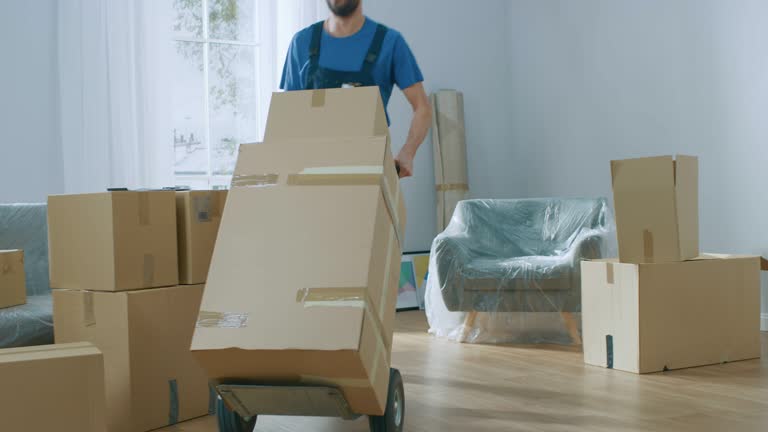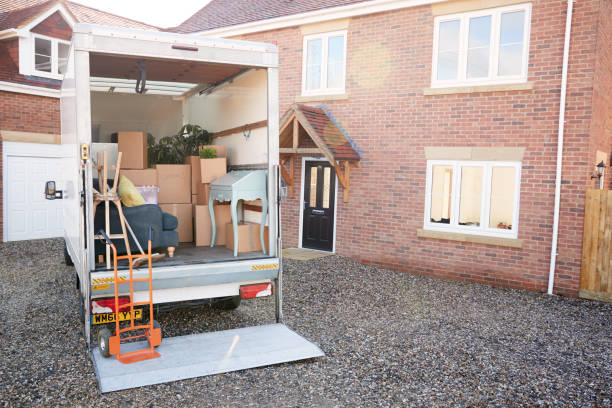How to Prepare for a Long Distance Move
Are you getting ready for a long-distance move? You’re in luck! This article will guide you through the process of preparing for your big move.
Assess your needs and budget, research and choose a reliable moving company, declutter and organize your belongings, pack strategically, manage essential paperwork, plan for transportation and logistics, address insurance, update important contacts, and take care of your personal and emotional preparation.
Let’s get started!
Assessing Your Needs and Budget
 Assessing your needs and budget is crucial before embarking on a long distance move.
Assessing your needs and budget is crucial before embarking on a long distance move.
Firstly, consider the size of your move and the distance you will be traveling. This will help determine the type of transportation and the amount of time it will take.
Next, evaluate your budget. Moving long distance can be expensive, so it’s important to set a realistic budget and stick to it. Research different pricing options and get quotes from multiple moving companies. This will give you an idea of the costs involved and help you make an informed decision.
Remember, it’s not just about finding the cheapest option, but also ensuring that the company meets your needs and provides reliable service.
Researching and Choosing a Moving Company
When researching and choosing a moving company, you’ll want to check online reviews and ask for recommendations from friends and family.
It’s important to find a reliable moving company that will handle your belongings with care and provide excellent customer service.
Start by researching different moving companies in your area. Look for companies with positive customer reviews and a good reputation for reliability.
Reading online reviews can give you insight into the experiences of previous customers and help you make an informed decision.
Additionally, ask friends and family if they have any recommendations based on their own experiences. They may be able to provide valuable insights and suggestions.
Decluttering and Organizing Your Belongings
To make the moving process easier, start by decluttering and organizing your belongings.
Decluttering is an essential step before any long-distance move. It’s time to let go of items you no longer need or use. Begin by sorting your belongings into three categories: keep, donate, and discard. This will help you create a clear plan and make packing much simpler.
Organizing your belongings is equally important. Categorize items by room or type, and label each box accordingly. This will save you time and effort when unpacking in your new home. Consider using storage containers or bins for fragile or valuable items.
Packing Strategically and Efficiently
Make sure you pack strategically and efficiently by starting with the items you use least frequently.
When packing for a long distance move, it’s important to prioritize and plan ahead. Begin by boxing up the items that you rarely use, such as seasonal clothing or holiday decorations. This way, you can focus on packing the essentials as you get closer to your moving date.
When it comes to packing furniture, disassemble any pieces that can be taken apart to save space and make them easier to transport. Use sturdy boxes and secure them with tape to protect your items during the move.
If you find the task overwhelming, consider hiring professional packing services to make the process smoother and more efficient.
Managing Essential Documents and Paperwork
 Managing essential documents and paperwork can be simplified by creating a designated folder for important files. When preparing for a long-distance move, it’s crucial to keep all your important documents organized and easily accessible.
Managing essential documents and paperwork can be simplified by creating a designated folder for important files. When preparing for a long-distance move, it’s crucial to keep all your important documents organized and easily accessible.
Start by gathering essential paperwork such as lease agreements, insurance policies, and medical records. Place them in a designated folder or binder, ensuring they are well-protected. This will not only make it easier to locate important documents during the move but also ensure they are safe and secure.
Additionally, it’s essential to keep any paperwork related to the moving process in this folder, including contracts with the moving company, storage services, and truck rental agreements. By having all your documents in one place, you can confidently navigate the moving process and stay organized throughout the transition.
Arranging for Utilities and Services at Your New Home
When arranging for utilities and services at your new home, remember to contact the necessary providers well in advance to ensure a smooth transition.
Moving to a new home, especially a long distance move, can be overwhelming, but taking care of these essential tasks early on can make the process much easier.
Start by contacting your local utility companies to transfer or set up your electricity, gas, water, and internet services. Make a list of the services you will need in your new home, such as cable or satellite TV, trash collection, and home security.
Research the providers in your new area and schedule installation appointments ahead of time. By arranging for utilities and services in advance, you can avoid any last-minute hassles and enjoy a seamless transition to your new home.
Planning for Transportation and Logistics
Planning for transportation and logistics can be a challenge when moving to a new home, but with careful organization and preparation, the process can go smoothly.
Start by considering your transportation options. Will you be driving your own vehicle to the new location or hiring a professional moving company? If you choose to drive, make sure your vehicle is in good condition and plan for any necessary maintenance or repairs before the relocation.
Logistics also play a crucial role in a successful move. Create a detailed plan that includes the timeline, budget, and resources required for the transportation of your belongings. Research different shipping and storage options to find the most cost-effective and efficient solutions.
Addressing Insurance and Valuables Protection
To ensure the safety of your valuables during the move, it’s essential to research and select the right insurance coverage for your belongings. Paying attention to insurance and valuables protection will give you peace of mind throughout the moving process.
When choosing an insurance provider, it’s important to find a trustworthy and experienced company that understands the unique needs of your move. Look for a provider that offers comprehensive coverage for your valuables, including protection against damage, loss, and theft.
Take the time to review the policy details and ask questions to ensure you fully understand what is covered and any limitations or exclusions. By investing in the right insurance coverage, you can rest easy knowing that your valuables are protected during the move.
Communicating and Updating Important Contacts
 Updating your important contacts is crucial for a smooth transition during your move.
Updating your important contacts is crucial for a smooth transition during your move.
Keeping your customers informed about your new address and contact information is essential to maintain their satisfaction and trust in your services.
Promptly notifying companies and professionals you regularly interact with, such as utility providers, insurance agents, and doctors, can help avoid disruptions in services and ensure a seamless transition.
Remember to update your address and contact information on all relevant platforms, including online accounts and social media profiles.
Don’t forget to inform your friends and family members about your new address.
Taking the time to update your important contacts will save you from any last-minute confusion or delay in booking important services during your move.
Taking Care of Personal and Emotional Preparation
Taking care of your emotional well-being is just as important as the physical aspects of preparing for a long-distance move.
Moving can be a stressful and overwhelming experience, but by prioritizing your personal and emotional preparation, you can make the process smoother and more manageable.
Start by acknowledging and validating your emotions. It’s normal to feel a mix of excitement, anxiety, and sadness when leaving behind familiar surroundings. Take time to reflect and process these emotions, whether through journaling, talking to a trusted friend or therapist, or engaging in self-care activities.
Additionally, make sure to create a support system for yourself. Reach out to friends and family, lean on them for emotional support, and ask for help when needed.
Conclusion
 In conclusion, preparing for a long distance move requires careful planning and organization. By assessing your needs and budget, researching and choosing a moving company, and decluttering and organizing your belongings, you can ensure a smoother transition.
In conclusion, preparing for a long distance move requires careful planning and organization. By assessing your needs and budget, researching and choosing a moving company, and decluttering and organizing your belongings, you can ensure a smoother transition.
Packing strategically is also important. Managing essential documents and paperwork, planning for transportation and logistics, and addressing insurance and valuables protection are crucial steps. Additionally, communicating with important contacts is essential.
Lastly, don’t forget to take care of your personal and emotional preparation, as moving can be a stressful experience.












